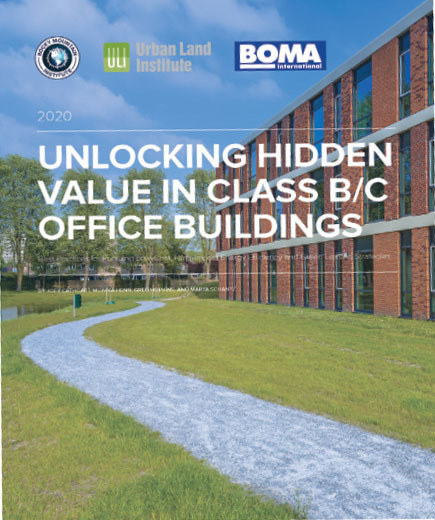COVID-19 has disrupted business as usual and shifted the focus of virtually all building owners and managers away from reinvigorating assets towards crisis management. Nevertheless, Class B and C buildings have a lot to gain by pursuing low-cost, high-impact energy-efficiency strategies and initiatives, even now. While utility cost savings are an obvious benefit, sustainable spaces can create additional value by leasing more quickly and increasing lease renewals to avoid tenant turnover costs.
These strategies also enhance building value by decreasing risks. As local benchmarking ordinances and building-performance regulations phase in compliance for smaller properties, those property professionals who already have completed efficiency measures will be ahead of the market and avoid noncompliance penalties.
With this largely untapped business opportunity at hand, why haven’t more Class B and C property managers adopted energy-efficient and green-leasing practices? They face three primary constraints that most of their Class A colleagues do not:
- With fewer dedicated on-site staff, building managers rarely have time to focus on identifying and implementing efficiency initiatives;
- Limited staff time as a result of smaller teams can create information constraints that result in a knowledge gap about operational practices; and
- Funding constraints make it difficult to invest in retrofits with high upfront costs.
To streamline energy-efficiency and green-leasing opportunities for these properties and to overcome market limitations, BOMA International, the Urban Land Institute (ULI) and the Rocky Mountain Institute (RMI) published Unlocking Hidden Value in Class B/C Office Buildings: Best Practices for Pursuing Low-Cost, High-Impact Energy Efficiency and Green Leasing Strategies (pictured, above), a newly released report sponsored by Yardi. Distilled from best practices and expert real estate leader input, the report recommends key building-level strategies to drive value.
Following is a sampling of tips, pulled from the guide (pictured, above), to show how owners and managers can start capitalizing immediately on their buildings’ energy and green-leasing potential:
- Collect performance data. You can’t manage what you don’t measure. Unfortunately, very few Class B and C office assets benchmark their energy performance, either against themselves or similar buildings over time. This can be done for free in the U.S. Environmental Protection Agency’s ENERGY STAR® Portfolio Manager® tool. The minimal time investment to collect and review energy-performance data can yield savings by identifying abnormal energy-use trends, as well as tracking how use and costs change over time.
- Implement low- and no-cost measures. Achieve quick paybacks through LED lighting replacements and sensors; optimized heating, ventilating and air-conditioning (HVAC) start-up/shutdown schedules and widened setpoints; regular building walkthroughs; and ongoing preventive maintenance, all of which require limited investments.
- Engage tenants. Enhancing tenant awareness of energy-saving behaviors, such as turning off lights and appliances when not in use or leveraging natural daylight, can lower energy use and costs. Owners can communicate these practices through a tenant guide outlining sustainable practices, newsletters, Earth Day programming, signage, competitions and data transparency.
- Incorporate green lease clauses. Included at the time of a new lease signing or renewal, green lease clauses can document efficient operations, establish efficiency standards for tenant fit-outs and enable cost recovery for efficiency projects. Green leases also align property professionals and tenants on a building’s sustainability practices, creating greater tenant satisfaction. BOMA International offers a free green leasing guide, which can be accessed at www.boma.org/GreenLeaseGuide.
- Perform an energy audit. Audits conducted by local professionals help owners and managers identify cost-effective and site-specific energy-efficiency improvement measures and often can be funded through local incentives. Frequently, an audit report provides cost and savings estimates on recommended conservation measures and, therefore, can be used to build the financial case for implementation.
- Perform retrocommissioning (RCx). Proactive RCx and regular building tune-ups ensure that a building automation system and all building equipment function properly, lengthening the system’s life span and improving efficiency. This lowers energy costs, as well as repair and maintenance costs.
- Consider capital improvements. Building envelope repairs, renewable energy systems and higher-efficiency equipment replacements at their end of useful life are all major investments that can substantially lower energy use. Owners can bundle energy-efficiency measures into larger building improvements, such as LED lights in a lobby renovation or solar panels in a roof replacement.
- Include sustainability improvements in planned repositioning. Value-add investments, such as new fixtures, HVAC systems and building automation systems, improve the overall tenant experience, while lowering current and prospective tenants’ overall costs.

Class B and C buildings have a lot to gain by pursuing low-cost, high-impact energy-efficiency strategies and initiatives, even now. While utility cost savings are an obvious benefit, sustainable spaces can create additional value by leasing more quickly and increasing lease renewals to avoid costly tenant turnover.
There is no reason why Class B and C office property owners and managers cannot access the same performance benefits typically enjoyed by their Class A counterparts. For more detailed strategies and case studies on unlocking the hidden value in these assets, go to www.boma.org/ClassBCEnergyEfficiency.
ABOUT THE AUTHORS: Monika Henn is a manager of the Urban Land Institute Greenprint Center for Building Performance. Marta Schantz is senior vice president of the Greenprint Center.